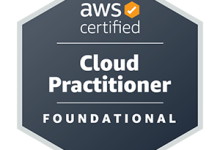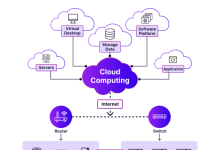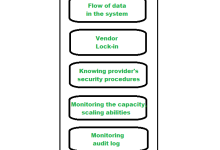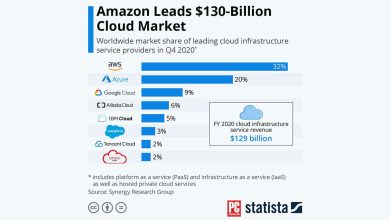which option refers to a combination of the three main services in cloud computing?
Ads
Introduction
Cloud computing has revolutionized the way businesses operate by offering a wide range of services for storing, processing, and managing data. Among the three main services in cloud computing – Infrastructure as a Service (IaaS), Platform as a Service (PaaS), and Software as a Service (SaaS) – there is an option that combines all three services into a single package, providing users with a comprehensive solution for their IT needs.
This article delves into the intricacies of this option and explores its strengths and weaknesses, shedding light on why businesses should consider incorporating it into their operations. By understanding the benefits and challenges associated with this combined service offering, businesses can make informed decisions about leveraging cloud computing to drive growth and innovation.
The fusion of IaaS, PaaS, and SaaS offers a holistic approach to cloud computing, allowing businesses to access a complete suite of services that cater to their infrastructure, platform, and software requirements. This integrated solution simplifies the management of IT resources, streamlines processes, and enhances overall efficiency.
As businesses increasingly rely on cloud technologies to support their operations, the option to combine IaaS, PaaS, and SaaS becomes a compelling choice for organizations looking to optimize their IT infrastructure and drive digital transformation.
Strengths of the Combined Services
The integrated offering of IaaS, PaaS, and SaaS brings several advantages to businesses, including:
1. Cost-Efficiency
By bundling the three main services into a single package, businesses can benefit from cost savings compared to purchasing each service separately. This cost-efficiency is particularly advantageous for small and medium-sized enterprises looking to maximize their IT budget.
2. Scalability
The combined services offer scalability, allowing businesses to easily adjust their resources based on fluctuating demands. Whether scaling up during peak periods or scaling down during off-peak times, organizations can adapt their IT infrastructure to meet their specific needs.
3. Flexibility
With IaaS, PaaS, and SaaS integrated into one solution, businesses gain greater flexibility in deploying and managing their applications and services. This flexibility enables seamless collaboration, enhances workflow efficiency, and supports innovation within the organization.
4. Simplified Management
Having a unified platform for infrastructure, platform, and software services simplifies IT management for businesses. They can centralize their operations, streamline processes, and reduce the complexity associated with managing multiple vendors and solutions.
5. Improved Security
The combined services offer enhanced security features, ensuring that businesses’ data and applications are protected from external threats. With robust security measures in place, organizations can mitigate risks and safeguard their digital assets effectively.
6. Rapid Deployment
Businesses can quickly deploy and implement the integrated services, enabling them to accelerate their digital transformation initiatives. The ease of deployment allows organizations to optimize their IT infrastructure and drive business growth more efficiently.
7. Enhanced Collaboration
The integration of IaaS, PaaS, and SaaS promotes collaboration among teams by providing a shared platform for accessing and sharing resources. This collaborative environment fosters communication, innovation, and teamwork, leading to increased productivity and creativity.
Weaknesses of the Combined Services
Despite the numerous benefits, the combined services of IaaS, PaaS, and SaaS also have certain limitations that businesses should consider:
1. Dependency on a Single Vendor
Choosing a bundled service offering may lead to vendor lock-in, limiting businesses’ flexibility to switch providers or customize solutions. This dependency on a single vendor could pose challenges in the long run if the vendor fails to meet service expectations or changes their pricing structure.
2. Complexity in Integration
Integrating and managing the combined services can be complex, requiring specialized expertise and resources to ensure a seamless deployment. Businesses may encounter challenges in merging different service components, troubleshooting issues, and maintaining compatibility across platforms.
3. Limited Customization
While the integrated services offer a comprehensive solution, they may lack the flexibility to tailor services to specific business requirements. Organizations with unique needs or specialized applications may find it challenging to customize the bundled offering to meet their exact specifications.
4. Potential Security Risks
Consolidating infrastructure, platform, and software services into a single package could introduce security vulnerabilities, making businesses more susceptible to cyber threats and data breaches. It is crucial for organizations to implement robust security measures and protocols to mitigate these risks effectively.
5. Performance Bottlenecks
Depending on the service provider and the underlying infrastructure, businesses may encounter performance bottlenecks that impact the speed and reliability of their applications. It is essential to assess the performance metrics and service level agreements (SLAs) to ensure optimal service delivery.
6. Compliance Challenges
Businesses operating in regulated industries or regions may face compliance challenges when using combined cloud services. Ensuring adherence to data protection regulations, industry standards, and legal requirements becomes critical to avoid potential penalties or fines.
7. Risk of Service Disruption
In the event of service outages, downtime, or disruptions, businesses relying on bundled cloud services may experience significant interruptions to their operations. Developing a robust disaster recovery and business continuity plan is essential to minimize the impact of service disruptions and ensure continuity.
Table: Comparison of IaaS, PaaS, SaaS, and Combined Services
| Service Type | Key Features | Strengths | Weaknesses |
|---|---|---|---|
| IaaS | Infrastructure provisioning, virtualization | Scalability, flexibility | Management complexity, security risks |
| PaaS | Development tools, middleware | Rapid deployment, collaboration | Integration challenges, customization limitations |
| SaaS | Software applications, cloud storage | Usability, cost efficiency | Vendor lock-in, compliance risks |
| Combined Services | Integrated IaaS, PaaS, SaaS | Cost-efficiency, scalability | Dependency on vendor, complexity in integration |
Frequently Asked Questions (FAQs)
1. What are the benefits of combining IaaS, PaaS, and SaaS?
Combining IaaS, PaaS, and SaaS offers cost-efficiency, scalability, flexibility, simplified management, enhanced security, rapid deployment, and improved collaboration.
2. How can businesses mitigate the risks associated with bundled cloud services?
Businesses can mitigate risks by implementing robust security measures, ensuring compliance with regulations, diversifying service providers, and developing contingency plans for service disruptions.
3. Is vendor lock-in a concern with combined cloud services?
Vendor lock-in can be a concern with bundled services, as businesses may face challenges in switching providers or customizing solutions to meet their specific needs.
4. What factors should businesses consider when evaluating combined cloud services?
Businesses should consider factors such as cost-effectiveness, scalability, flexibility, security, performance, customization options, compliance requirements, and vendor reputation when evaluating combined cloud services.
5. How can businesses ensure seamless integration of IaaS, PaaS, and SaaS?
Seamless integration requires proper planning, expertise, and collaboration between IT teams and service providers to ensure compatibility, data migration, and interoperability across different platforms.
6. What are the potential challenges of managing a bundled cloud service offering?
The challenges include complexity in integration, customization limitations, security vulnerabilities, performance bottlenecks, compliance issues, and the risk of service disruptions that may impact business continuity.
7. How can businesses leverage the combined services to drive innovation?
Businesses can leverage the combined services to drive innovation by integrating new technologies, enhancing collaboration among teams, optimizing IT resources, accelerating digital transformation, and improving overall efficiency and productivity.
Conclusion
In conclusion, the option that refers to a combination of the three main services in cloud computing provides businesses with a comprehensive solution that integrates infrastructure, platform, and software services into a cohesive offering. While the combined services offer numerous strengths, including cost-efficiency, scalability, flexibility, and enhanced security, businesses should also be aware of the potential weaknesses, such as vendor dependencies, integration complexity, and compliance challenges.
By weighing the benefits and drawbacks of the integrated services, businesses can make informed decisions about adopting this option to optimize their IT infrastructure, drive innovation, and stay competitive in today’s digital landscape. As cloud computing continues to evolve, leveraging the combination of IaaS, PaaS, and SaaS can enable businesses to maximize their resources, enhance collaboration, and achieve their strategic objectives effectively.
Empower your organization with the combined services of cloud computing and unleash the full potential of your IT capabilities. Embrace innovation, drive growth, and transform your business operations by harnessing the power of integrated infrastructure, platform, and software services.
Take the next step towards a more agile, efficient, and secure IT environment with the option that combines the three main services in cloud computing. Seize the opportunities that cloud technology offers and propel your organization towards success in the digital age.
Disclaimer
The information provided in this article is for educational and informational purposes only. It does not constitute professional advice or recommendations. Readers are advised to consult with qualified professionals and conduct thorough research before making any decisions based on the content presented.









